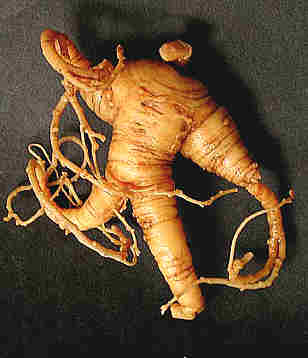
Plant Description
Caution & Interaction

Latin (botanical) name:
Hydrastis canadensis
Common names: Yellowroot, Yellow Puccoon, Orange-Root, Yellow Indian Paint, Turmeric Root, Indian Turmeric, Ohio Curcuma, Ground Raspberry, Eyeroot, Eyebalm, Yelloweye, Jaundice Root, Indian Dye
Plant Description: Goldenseal is a native forest plant found growing in patches in high, open woods and hillsides or bluffs. It can be found from western New England to Minnesota and western Ontario, and as far south as Georgia and Missouri. Goldenseal has a thick, bright yellow rootstock (hence the name), which is somewhat human shaped, and an erect hairy stem about 1 foot in height. Near the top, the stem branches out with one branch bearing a large leaf and another branch with a smaller leaf and a flower. The leaves have between five and nine lobes and grow to be 6-8 inches in diameter. The flowers, which bloom around April or May, are greenish-white. Not the most attractive flower in the forest, it has an unusual shape and a large, lumpy, berrylike head that looks a little like a raspberry. It ripens in the fall and turns a bright red. It contains 10-20 small, hard, shiny black seeds. The rootstock, collected in autumn after the seeds are ripe, and the leaves are used medicinally.
Medicinal Properties &Uses: Goldenseal is a native North American medicinal plant introduced to early settlers by Cherokee Indians who used it as a wash for skin diseases, wounds, and for sore, inflamed eyes. It is one of the major herbs used for prevention and healing. The active ingredients in Goldenseal are the immune-supporting alkaloids hydrastine, canadine, and berberine which destroy many types of bacterial and viral infections. These alkaloids also relieve congestion and fight against upper respiratory tract infections. Goldenseal is considered to be one of the best infection fighters. Studies show that it may calm infections in the mucous mentranes anywhere in the body. It also contains a natural antibiotic. It has been known to reduce gastric inflammation due to the alkaloid berberine which aids digestion and acts as a sedative to the central nervous system. It also aids digestion by promoting the production of saliva, bile, and other digestive enzymes. It promotes the functioning capacity of the heart, the lymphatic and respiratory system, the liver, the spleen, the pancreas, and the colon. Goldenseal has proven effective in lowering blood sugar, and is a source of natural insulin. It is also known to be an excellent contact healer, stopping internal and external bleeding and reducing swelling. Additionally, Goldenseal may control heavy menstrual and postpartum bleeding by means of its astringent action.
Dosage: 20-40 drops in water or juice, 2-3 times daily, or as needed. Shake well before using.
Cautions & Interactions: Do not use during pregnancy. Keep out of reach of children.
Efficacy Studies & Other Clinical Data: Helpful Links:
Disclaimer (U.S. Only): These statements have not been evaluated by the FDA. These products are not intended to diagnose, cure, treat, or prevent any disease.
Common names: Yellowroot, Yellow Puccoon, Orange-Root, Yellow Indian Paint, Turmeric Root, Indian Turmeric, Ohio Curcuma, Ground Raspberry, Eyeroot, Eyebalm, Yelloweye, Jaundice Root, Indian Dye
Plant Description: Goldenseal is a native forest plant found growing in patches in high, open woods and hillsides or bluffs. It can be found from western New England to Minnesota and western Ontario, and as far south as Georgia and Missouri. Goldenseal has a thick, bright yellow rootstock (hence the name), which is somewhat human shaped, and an erect hairy stem about 1 foot in height. Near the top, the stem branches out with one branch bearing a large leaf and another branch with a smaller leaf and a flower. The leaves have between five and nine lobes and grow to be 6-8 inches in diameter. The flowers, which bloom around April or May, are greenish-white. Not the most attractive flower in the forest, it has an unusual shape and a large, lumpy, berrylike head that looks a little like a raspberry. It ripens in the fall and turns a bright red. It contains 10-20 small, hard, shiny black seeds. The rootstock, collected in autumn after the seeds are ripe, and the leaves are used medicinally.
Medicinal Properties &Uses: Goldenseal is a native North American medicinal plant introduced to early settlers by Cherokee Indians who used it as a wash for skin diseases, wounds, and for sore, inflamed eyes. It is one of the major herbs used for prevention and healing. The active ingredients in Goldenseal are the immune-supporting alkaloids hydrastine, canadine, and berberine which destroy many types of bacterial and viral infections. These alkaloids also relieve congestion and fight against upper respiratory tract infections. Goldenseal is considered to be one of the best infection fighters. Studies show that it may calm infections in the mucous mentranes anywhere in the body. It also contains a natural antibiotic. It has been known to reduce gastric inflammation due to the alkaloid berberine which aids digestion and acts as a sedative to the central nervous system. It also aids digestion by promoting the production of saliva, bile, and other digestive enzymes. It promotes the functioning capacity of the heart, the lymphatic and respiratory system, the liver, the spleen, the pancreas, and the colon. Goldenseal has proven effective in lowering blood sugar, and is a source of natural insulin. It is also known to be an excellent contact healer, stopping internal and external bleeding and reducing swelling. Additionally, Goldenseal may control heavy menstrual and postpartum bleeding by means of its astringent action.
Dosage: 20-40 drops in water or juice, 2-3 times daily, or as needed. Shake well before using.
Cautions & Interactions: Do not use during pregnancy. Keep out of reach of children.
Efficacy Studies & Other Clinical Data: Helpful Links:
Disclaimer (U.S. Only): These statements have not been evaluated by the FDA. These products are not intended to diagnose, cure, treat, or prevent any disease.